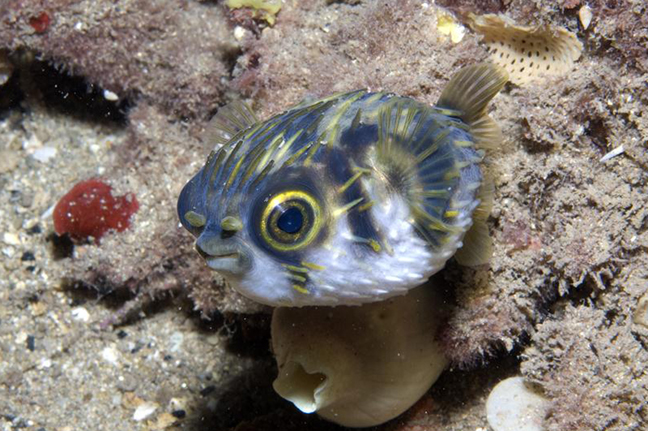- Classification
- ACTINOPTERYGII
- TETRAODONTIFORMES
- DIODONTIDAE
- Diodon
- nicthemerus
Globefish, Diodon nicthemerus Cuvier 1818

A Globefish, Diodon nicthemerus. Source: Mark Norman / Museum Victoria. License: CC by Attribution
A common porcupinefish with 3-4 dark vertical bands or blotches on the sides, and long white to yellowish spines that usually lie flat against the body.
When threatened, globefish rapidly inflate themselves with water or air to become spherical in shape. This causes the spines to stand out from the body, making it very difficult for predators to attack.
Globefish, Diodon nicthemerus Cuvier 1818
More Info
|
Distribution |
Endemic to the southern half of Australia from Seal Rocks, New South Wales to the Houtman Abrolhos, Western Australia, including Tasmania. Common and widespread in a range of habitats, preferring sheltered reefs, and often seen in weedy areas, around jetties and pylons, in depths to 85 m. |
|
Features |
Dorsal fin 12-13; Anal fin 12-14; Caudal fin 9; Pectoral fin 19-21. Body deep (42-52% SL deflated), moderately short, circular in cross section, capable of being inflated into sphere; caudal peduncle very shallow, rather short. Head large (42-47% SL), snout short; eyes large (29-32% HL); mouth broad (length to corner 19-23% HL); teeth fused into beak like jaws, no seam separating right and left halves; gill opening on each side confined to short vertical slit immediately before pectoral fin base. Scales and lateral line absent. Body covered with long slender erectile spines, each with pair of opposing basal roots; many spines equal to or longer than eye diameter; no spines wholly on caudal peduncle; area above and immediately in front of gill openings without small fixed or flattened spines. Single lobe like opposing dorsal and anal fins, each with short base, overhanging caudal peduncle; caudal fin rounded. Pectoral fins large, shallow notch in hind margin. Pelvic fins absent. |
|
Size |
To 30 cm, although most grow to about 15 cm. |
|
Colour |
Greenish blue to brownish above, white to silvery below with four dark bars on each side, including below eye; spines, including base, in darkly coloured area yellow, others white; fins yellowish green. |
|
Feeding |
Feeds mostly on hard-shelled invertebrates that live on the bottom. |
|
Biology |
Females spawn pelagic eggs and the larvae pass through a pelagic juvenile phase. |
|
Fisheries |
Of no interest to fisheries. |
|
Conservation |
|
|
Remarks |
Globefish avoid being swallowed by inflating their bodies with water and erecting their spines to greatly expand their size. Some species belonging to the family Diodontidae have the poison tetrodotoxin in their internal organs. |
|
Etymology |
The specific name nicthemerus is from the Greek nyctos (= night) and hemera (= day), possibly in reference to the dark upper side and silvery-white underside. |
|
Species Citation |
Diodon nicthemerus Cuvier, 1818, Mém. Mus. Nat. d'Hist. Nat. 4: 135, pl. 2. Type locality: Australian seas. |
|
Author |
Bray, D.J. 2021 |
|
Resources |
Globefish, Diodon nicthemerus Cuvier 1818
References
Castelnau, F.L. de 1872. Contribution to the ichthyology of Australia. 1. The Melbourne fish market. Proceedings of the Zoological and Acclimatisation Society of Victoria 1: 29-242 1 pl (p. 210, described as Diodon blochii).
Cuvier, G.L. 1818. Sur les diodons, vulgairement orbes épineux. Mémoires du Muséum Nationale d'Histoire Naturelle. Paris 4: 121-138 2 pls.
Edgar, G.J. 2008. Australian Marine Life: the plants and animals of temperate waters. Sydney : Reed New Holland 2nd edn, 624 pp.
Gomon, M.F. 2008. Famiuly Diodontidae. pp. 857-858 in Gomon, M.F., Bray, D.J. & Kuiter, R.H. (eds). Fishes of Australia's Southern Coast. Sydney : Reed New Holland 928 pp.
Gomon, M.F., Glover, C.J.M. & Kuiter, R.H (eds) 1994. The Fishes of Australia's South Coast. Adelaide : State Printer 992 pp. 810 figs
Hoschke, A., Whisson, G. & Moore, G.I. 2019. Complete list of fishes from Rottnest Island. pp. 150-161 in Whisson, G. & Hoschke, A. (eds) The Rottnest Island fish book. 2nd ed. Perth, Western Australia : Aqua Research and Monitoring Services.
Hutchins, J.B. 1994. A survey of the nearshore reef fish fauna of Western Australia's west and south coasts — The Leeuwin Province. Records of the Western Australian Museum, Supplement 46: 1-66 figs 1-6
Hutchins, J.B. & Thompson, M. 1983. The Marine and Estuarine Fishes of South-western Australia. Perth : Western Australian Museum 103 pp. 345 figs.
Kuiter, R.H. 1993. Coastal Fishes of South-eastern Australia. Bathurst : Crawford House Press 437 pp.
Kuiter, R.H. 1996. Guide to Sea Fishes of Australia. A comprehensive reference for divers and fishermen. Sydney, NSW, Australia : New Holland Publishers xvii, 434 pp.
Last, P.R., Scott, E.O.G. & Talbot, F.H. 1983. Fishes of Tasmania. Hobart : Tasmanian Fisheries Development Authority 563 pp. figs
Leis, J.M. 1978. Systematics and zoogeography of the porcupinefishes (Diodon, Diodontidae, Tetraodontiformes), with comments on egg and larval development. Fishery Bulletin (U.S.) 76(3): 535-567 figs 1-28.
Leis, J.M. 2006. Nomenclature and distribution of the species of the Porcupinefish family Diodontidae (Pisces, Teleostei). Memoirs of Museum Victoria 63(1): 77-90
Leis, J.M. & Bauchot, M.L. 1984. Catalogue critique des types de Poissons du Muséum national d'Histoire naturelle. (Famille des Diodontidae). Bulletin du Muséum National d'Histoire Naturelle. Paris 4 6(A)(3): 83-101.
Scott, T.D., Glover, C.J.M. & Southcott, R.V. 1974. The Marine and Freshwater Fishes of South Australia. Adelaide : Government Printer 392 pp. figs. (as Atopomycterus nicthemerus)
Swainston, R. 2011. Swainston's Fishes of Australia: The complete illustrated guide. Camberwell, Victoria : Penguin Australia 836 pp.
Waite, E.R. 1921. Illustrated catalogue of the fishes of South Australia. Records of the South Australian Museum (Adelaide) 2(1): 1-208 293 figs pl. 1 (as Atopomycterus nicthemerus)











